Cold hot spot
Over the past years, large deposits of oil (up to 30 percent of world reserves) and gas (up to 13 percent), diamonds, platinum, gold, tin, manganese, nickel, and lead have been found in the Arctic. According to some estimates, the total value of minerals in the arctic zone of Russia can reach 30 trillions of dollars. In general, the Arctic gives 11 percent of Russia's national income. Changing climatic conditions facilitate access to mining and mining. The warming makes it possible to use the Northern Sea Route more widely for transporting goods between Europe and Asia, and the fact that the Northern Sea Route, which has great prospects, is under the control of Russia, strongly dislikes some Western countries.
Time strategic decisions
The Arctic Territories have been regulated by the UN Convention on the Law of the Sea since 1982. Article 76 of this convention states that states having access to the Arctic Ocean may declare their territory in 200 nautical miles from their coast as their exclusive economic zone. And if the country is able to prove that the shelf is a continuation of its land territory, then it is entitled to get another 150 nautical miles. While the dome of the planet was covered with ice, these questions were of little interest to anyone, but the Arctic shell began to decrease and the situation changed.
It became easier to extract gas and oil on the shelf, and countries, both polar and very far from local places, like India or China, began to promote their interests in the region. More often, there were calls for Russia to share the water area and its resources, to make the passage along the Northern Sea Route free. And the leadership of the country had to take up the defense of our interests.
During the reform of the army, new military districts were created. Western headquarters in St. Petersburg laid the responsibility for the European part of the country, including the Arctic. The Asian part of the Arctic is the responsibility of the Eastern Military District. By 2014, it became clear that the size of the ZVO is somewhat large. After the return of Crimea to Russia, the second Cold War essentially began. The objectives of the ZVO have changed significantly. The top military-political leadership decided to divide the Western District into two. The Northern Fleet was withdrawn from the ZVO and from December 1, 2014 was transformed into the joint strategic command "North". Now, for the defense of the Russian sector of the Arctic from the north-west and north, this newly created command is responsible. The defense of the north-east direction remained in the area of responsibility of the BBO. Probably, it would be worthwhile to transfer the entire Arctic coast to the area of responsibility of the new command, but then the Kamchatka-Chukchi group would have to be included in its composition. But after such changes from the Pacific fleet there would remain one coastal flotilla in Vladivostok, and the submarine forces of the Pacific Fleet in Kamchatka would be in dual subordination. In addition, it is difficult to manage parts across the Arctic from Severomorsk - after all, there are eight time zones. Therefore, the USS North is responsible for the defense of the sector from the border with Norway to the Wrangel Island, and then the Pacific Fleet is responsible. Let’s take a closer look at our Arctic forces.
Currently, the Northern Fleet includes the following main units and formations.
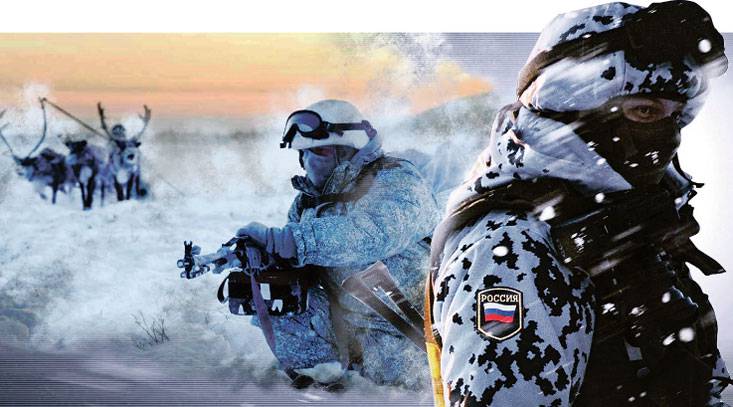
Andrei Sedykh collage
Submarine forces of the Federation Council are primarily four divisions of submarines: 7-I in Vidyayev, 11-I in Zaozersk, 24 and 31-I in Gadzhiyev. The main strike surface unit of the fleet is the 43-division of rocket ships in Severomorsk.
The Kola flotilla of heterogeneous forces is composed of a brigade: 7 th surface, 14 th anti-submarine and 121 th landing ships, 161 th submarines, 536 th coastal missile.
Subdivisions of the White Sea Naval Base are based in Severodvinsk. These are brigades of repairing ships (16-I) and submarines under construction and repairing (336-I), as well as the 43-th division of IAD ships.
All in all, the NF is armed with 24 submarines (of which seven are with ballistic and four with cruise missiles on board) and six diesel. The surface forces are represented by giants of the Soviet era: TARKR Peter the Great and Admiral Nakhimov, the Marshal Ustinov missile cruiser, the aircraft carrier Admiral Kuznetsov, the Ushakov destroyer. Large anti-submarine ships "Admiral Chabanenko", "Admiral Levchenko", "Severomorsk", "Vice-Admiral Kulakov" and "Admiral Kharlamov". The first large ship of Russian construction - the frigate “Admiral Gorshkov” is still being tested. There are also six small anti-submarine and three intermarine ships, nine minesweepers and four landing craft.
The composition of the combat and logistic support units include intelligence, electronic warfare, communications and surveillance.
The rear of the fleet includes the logistics and logistics center, a detachment of support vessels, the rescue service and other parts, including hydrographic.
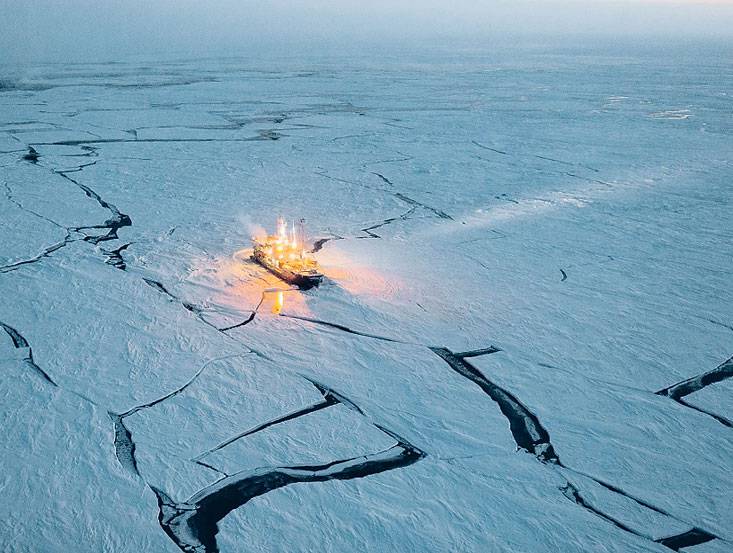
Since the military district relies on the Air Force and Air Defense Army, this was created at number 45 in 2015. Its structure included as parts of the marine aviation, and units of the former 1st command of the Air Force and Air Defense ZVO. Currently, it has 279 and 100 m naval fighter regiments with the Su-33 and MiG-29KR, respectively. The 7050th air base (IL-38, Tu-142MK, Ka-27) has two anti-submarine, one rescue and two helicopter squadrons. The 98th mixed air regiment in Monchegorsk includes squadrons of Su-24M bombers, Su-24MR scouts and MiG-31 fighters. On the Kola Peninsula, in Severodvinsk and on Novaya Zemlya, units of the 1st Air Defense Division were deployed. She is the direct heir to the famous 10th Air Defense Army, which covered the north of the country and Moscow from possible attacks by enemy aircraft.
But USC is not only ships and airplanes, but also divisions of coastal and land forces. The Northern Fleet already had the 61-I Marine Brigade and the 200-I Motorized Rifle, stationed near the town of Pechenga. They are standard parts. In 2014, plans for the creation of two special Arctic motorized rifle brigades were announced. The first was 80-i, created in 2015-m in Alakurti. The second was planned to be formed in 2016 on Yamal. However, at the moment there is no information about tenders for the construction of a military camp on this peninsula. Most likely, the Ministry of Defense is waiting for the results of the first, in many respects still experimental brigade. It receives a special arctic technique of high maneuverability, in particular, two-link all-terrain vehicles, snowmobiles and so on. The fighters with might and main are mastering both the Arctic methods of survival of small nations and the exotic transport - deer; they are studying ways of conducting combat operations in the Arctic.
In the 2014 – 2015 years, the 99-I tactical group was deployed on the Kotelny (Novosibirsk Islands). It consisted of an anti-aircraft missile and artillery division with the Pantsir-S1 air defense missile system and a coastal missile division with the Rubezh missile defense complex, command and control, communications and logistic units. Most likely, this example is the development of promising tactical groups that are planned to be placed on the islands in the future.
On Kamchatka and Chukotka are the units of the joint command of the troops and forces in the north-east of Russia (OKVS). The grouping includes brigades: 114 of surface ships, 40 of the marines, 520 of the coastal missile, and 53 of the air defense division, 7060 of the air base, combat and rear support units. In addition, submarine forces of the Pacific Fleet are stationed in Kamchatka as part of the 10 and 25 divisions of submarines. They are armed with the 15 nuclear submarine (six with ballistic and five with cruise missiles), two small anti-submarine ships, four MRK, three minesweepers.
Wiping white spots
In recent years, research on the Arctic Ocean has been sharply intensified, both for obtaining hydrographic and oceanographic information, as well as military profile.
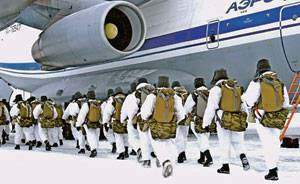 Previously, the top secret department of the GUGI began to be involved in activities in the interests of the national economy. Thus, in the Arktika-2012 expedition in the underwater drilling operations on the Lomonosov and Mendeleev ridges, a submarine known as the Losharik took part. The work was carried out with the aim of expanding the boundaries of Russia's continental shelf and, accordingly, increasing its economic zone. However, the UN Commission on the Law of the Sea has not taken a decision yet. With the entry into service of the cruiser GUGI "Yantar" research, of course, will continue.
Previously, the top secret department of the GUGI began to be involved in activities in the interests of the national economy. Thus, in the Arktika-2012 expedition in the underwater drilling operations on the Lomonosov and Mendeleev ridges, a submarine known as the Losharik took part. The work was carried out with the aim of expanding the boundaries of Russia's continental shelf and, accordingly, increasing its economic zone. However, the UN Commission on the Law of the Sea has not taken a decision yet. With the entry into service of the cruiser GUGI "Yantar" research, of course, will continue.Hydrographic expeditions to clarify the coastline of islands and straits, updating navigation maps were actively resumed at the Northern Fleet and the Pacific Fleet. In 2013, in the archipelago, the Novosibirsk Islands found a new geographical feature. The small (less than 500 square meters) island of Yaya gave the country 452 square miles of the exclusive economic zone. Russian geographical society also conducts a large number of different studies. The white spots of the Arctic are getting smaller.
An interesting point was the active development of high-latitude waters of warships. When the group of combat and auxiliary ships headed by Peter the Great 2013-th set off along the Northern Sea Route in the fall, all observers considered this to be a transfer of ships to the Pacific Ocean via the NSR. However, the group reached the New Siberian Islands and set about creating a base at the Kotelniy. It should be noted that in Soviet times the activity of the warships of the Northern Fleet in the Laptev Sea or East Siberia was not observed except for the transfer of ships to the Pacific Fleet through the NSR. And now the campaigns of warships in this region have become commonplace.
The peculiarity of the Arctic program of the Armed Forces of the Russian Federation is its complexity. It seems that nothing is forgotten, even questions of special military education. Thus, in the Far Eastern Higher Command School, officers are trained for operations in high latitudes. In the composition of the airborne forces, an arctic combat training center has been established.
Speaking of airborne. Parts of the main reserve of the Supreme Commander constantly participate in maneuvers and exercises behind the Arctic Circle, which is understandable. In the event of an attack on our outposts, the paratroopers will be the first to be thrown into battle.
Base, I see you!
After the 90-x in the North, in fact, only the military base on Novaya Zemlya survived, which is not surprising, since Russia’s only nuclear test site is located here. Currently, Spetsstroy Corporation is engaged in restoring the network of military bases on the islands and the coast of the Arctic Ocean.
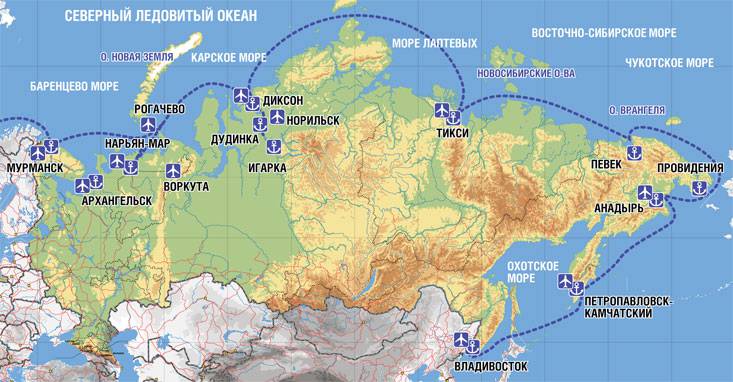
But the first outpost was the town of Nagurskoye border guards in Franz Josef Land. It is clear that this item was not created to catch migrants on the way from Somalia to Norway, but to display our flag on the most remote island. Currently, military camps are being built on Alexandra Land Island, where Nagurskoye is located, on Sredny (Severnaya Zemlya Archipelago), on Kotelniy. This division of the Federation Council. Garrisons on Wrangel Island and Cape Schmidt belong to the BBO.
Each such outpost is a mini-town with residential and warehouse facilities and an airfield with group parking, including a covered Su-34 bombing unit for accommodation. For them provides for the creation of heated hangars. The typical structure of military units at the outposts: the aviation commandant's office, a separate radar company, an aviation command post, an anti-aircraft missile artillery division, communications and support units. Thus, the garrison can monitor the surrounding territory, ensure the reception and basing of aircraft of any kind, including strategic bombers, to conduct self-defense.
The estimated cost of such a town with the reconstruction or construction of an airfield can reach four billion rubles. They are designed according to a closed technology, all structures, both residential and administrative buildings and boxes with military equipment, are connected by passages. Personnel may serve without leaving the premises.
Work is underway at the airfields of Severomorsk, Naryan-Mar, Vorkuta, Anadyr, Norilsk, Tiksi, Rogachevo, Ugolny. In total they plan to build or reconstruct 13.
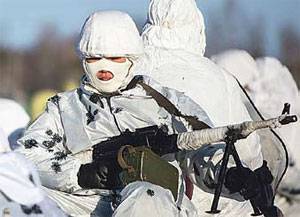
In Soviet times, on the same airfields in northern Russia, regiments of air defense fighters were based (Amderma, Kilp-Yavr, Rogachevo). Others, such as Vorkuta or Anadyr, served to disperse long-range aircraft during the war.
It is planned to create naval bases in the ports of Dikson, Pevek and Tiksi. It is possible the revival of an abandoned basing point in Yokange.
For such spaces as the Arctic Ocean, you must constantly monitor. For this purpose, the Unified State System for Lighting Surface, Submarine and Air Conditions is being created. It will consist of automated radio-technical units with radar detection of air and sea targets. Work is underway on the underwater lighting system. A single satellite communications complex is being formed with onshore facilities, ships, submarines and airplanes. A multi-purpose space system "Arktika" is being developed, which will include satellites of radar observation, communications and control, hydrometeorological observation.
An impressive replacement program is being implemented. weapons and military equipment. The Arctic Brigade receives TTM-1901 snowmobiles and DT-10PM two-link tracked vehicles.
It is planned to form a number of units of the Air Force and Air Defense, which will be located on military outposts under construction. An anti-aircraft missile regiment with the C-300 complex was formed on Novaya Zemlya island in Rogachev. The air defense forces receive C-400 complexes, two regiments are already re-equipped. Anti-aircraft missile and artillery divisions receive CRAFT "Pantsir-С1". As the coastal missile and artillery troops are saturated with the Bastion and Ball complexes, we should expect the creation of new tactical groups like the 99 deployed at the Kotelny, which includes Rubezh BRK and Pantsir-С1 SCRA units.
Aviation receives new upgraded anti-submarine aircraft IL-38H. In 2015, the second ship regiment was formed, fully armed with deck MiG-29KR, but it would take time for it to reach combat readiness. In the air defense appeared modernized MiG-31BM. After the completion of the reconstruction of the airfields, one should certainly expect the deployment of new air defense units on them. GC VCS has already announced plans to deploy MiG-2017 fighters in Tiksi, Anadyr and, possibly, on Novaya Zemlya in 31 year. We should expect the deployment of new front-line units with Su-34 bomber and Su-30CM attack aircraft. It is not excluded that the 279 th regiment will replace its Su-33 after the expiration of their life on the Su-34. A squadron, armed with Orlan-10 and Forpost unmanned aerial vehicles, is deployed in Kamchatka and Chukotka, a similar unit formed on the Kola Peninsula. In the future, these squadrons will become regiments. An arctic version of the Mi-171A2 helicopter is being created. VKS plans to purchase them to 100 pieces. So we should expect the formation of several helicopter regiments.
Undoubtedly, the most visible embodiment of any weapons programs is the construction of ships and submarines. In this regard, both the Federation Council and the OKVS are waiting for serious updates, although not as soon as we would like.
Particularly worth mentioning is the modernization program for surface ships and submarines. CS “Zvezdochka” is engaged in the modernization of the nuclear submarines of the 971 and 945 projects, repairs of the missile submarine cruisers of the 667BDRM project. The Zvezda plant in the Big Stone is upgrading the 949A submarines. In general, we can expect by the 2025 the second-breath year of all the existing third-generation submarines - these are eight boats with cruise missiles from the 949 project, four multi-purpose submarines of the 945 and 945 and 12 projects of the 971.
The Sevmash plant carries out the reconstruction of the nuclear cruiser Admiral Nakhimov. The previously announced deadline (2018) is postponed to 2020 year. After that, Peter the Great will take over the overhaul. The hull of the Frunze cruiser, also known as Admiral Lazarev, may be waiting for its time to recover in the Strelok Bay in Primorye. "Marshal Ustinov" in 2016-m should leave the territory of "Stars" and return to the Federation Council. The North Sea BOD began to undergo mid-life repairs with upgrades. The first of them, Admiral Chabanenko, will return to the fleet in 2018.
Under the program of military shipbuilding up to 2050, serious groundwork is being created for the development and renewal of the composition of the Federation Council and OKVS. True, the construction of a series of new frigates of the 22350 project “Admiral Gorshkov” is still stalled due to the lack of knowledge of radio-electronic systems and due to the reorientation of the production of gas turbine propulsion systems from Ukraine to Russia. There are programs for the construction of corvettes and other surface ships. Of particular note is the creation of multi-purpose icebreakers, such as the Ilya Muromets launched in St. Petersburg (see page 08 for details) and two patrol ships for the Arctic, which are expected to be laid this fall.
A program of construction of fourth-generation submarines is being carried out at Sevmash. In 2020 – 2025, the submarine forces of the Federation Council and the Pacific Fleet receive eight SSBNs of the 955A project (three already in the line) and seven multi-purpose 855 families (the head body in the line). But the diesel-electric submarine of the 677 project is stalled, and most likely several submarines of the 636.3 project will be ordered for the Northern Fleet in a couple of years, which are now being built for the Black Sea and Pacific Fleets (the “New Varshavyanka”).
In the interests of the FSB Border Service, a series of 22100 patrol ships is being built. The head of them - "Polar Star" is now completing the test. It is planned to build several more such ships.
This is for you, rescuers, this is for you, environmentalists
The Arctic zone is rich not only in the subsoil, but also in a large number of hazardous industries, nuclear facilities, which are under the scrutiny of the Ministry of Emergency Situations. The ministry deployed on the coast three integrated rescue centers in Arkhangelsk, Naryan-Mar and Dudinka, four regional search and rescue teams, 196 fire departments with a total of about 10 thousands.
In Soviet times, the issues of ecology and environmental protection were not given due attention. Nowadays, one of the important tasks solved by the military has been the cleaning of the coast from the remaining debris, mainly the fuel barrels. For this purpose, special units have been formed that collect scrap and utilize it.
It is planned to create a regional environmental center for the Northern Fleet, which will take over the functions of monitoring and controlling compliance with Russian and international environmental legislation both in the places of deployment of the fleet and army units, and in the entire Arctic zone.
Information